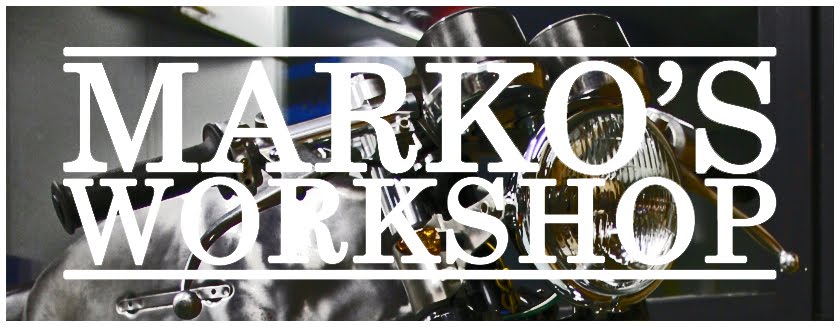Idea for this build started from this fuel tank, which had been for sale for a while in one Finnish spare parts advertisement website. I contacted the seller by phone and we settled a deal for the tank. He wasn't sure of the tanks origin. I believe it's originally from a Yamaha MX. Once the deal was done it didn't take long for it to arrive by mail.
 |
| Aluminum Yamaha MX fuel tank. |
Once I got it I noticed that the rear mounting bracket of the tank was broken. I removed the remains of it with an angle grinder and a sander. I cleaned the area below the old bracket with a sandblaster and a piece of sand paper.
I made a small bracket out of 3 mm aluminum sheet and bend it to a shape of a trapezoid. I finished it by filing a stadium shaped hole to bottom of it. Since I wasn't able to weld aluminum I visited Mikko from Speedhouse and he welded the bracket for me for a small reward. Mikko builds and maintains motorcycles for a living. You can find few pictures of the bikes he has build from his website:
http://www.speedhouse.fi/albumi/pyoria/.
Tank didn't came with any locating dampers so I had to order a pair of them (3TB-24181-00) from one of my local Yamaha parts dealer. Once I had them it was easy to design a front mounting bracket for the tank.
 |
| Tank had a broken rear mounting bracket. |
 |
| New one is made out of 3 mm aluminum sheet. |
 |
| Pair of locating dampers (3TB-24181-00). |
 |
| Underside of the tank. |
I started making the front mounting bracket by bending a suitable rounded shape out of approximately 80 mm wide steel sheet. I used 2 mm thick mild steel for two reasons. First one being formability and second structural strength. I made small bevels to both sides of the top plane of the bracket. That made sliding the tank to its place easier. I tack welded two thin pieces of sheet metal inside the bracket to keep the tank from moving sideways. Once that was done I tacked it to the top tube of the frame.
 |
| Finished front mounting bracket. |
 |
| Side view. |
 |
Bracket tacked to the top tube of the frame.
Seems like I forget to remove mill cinder before welding. |
Rear mounting bracket of the fuel tank needed a counter part, which I cut out of flat bar. I drilled a hole to the center of it and tacked a hexagon weld nut to the bottom of it. Once I figured the right angle for the tank I tacked the piece to the frame. I didn't want to weld either of the brackets definitively. If there's going to appear any fitment issues in the future, for example with triple clamps, it's easier to move their position.
 |
| Counter part for the rear mounting bracket. |
 |
| Both brackets tacked in place. |
 |
| Test fit. |
Next time I'm going to start fitting the aluminum RM/PE 250 swingarm, which you can see in the background. Stay tuned for that next week!













































